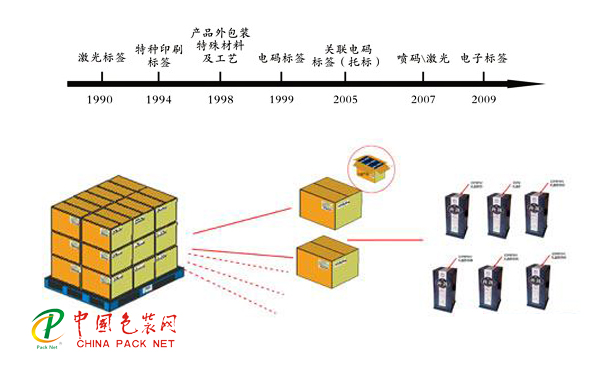Internet of Things and Packaging Anti-counterfeiting Integrated Solutions
[China Packaging Network News] Anti-counterfeiting is the most familiar word for everyone. The safety of products is related to the immediate interests of everyone, and the sales of goods will directly and indirectly affect the safety of products. This is a matter of particular concern to manufacturers.
The so-called “goods†are the individual entities in the distribution network. They are driven by interests. Products sold through cross-regional sales are often sold at prices lower than the normal sales prices of dealers in the region, leading to confusion in market prices in the region. The normal sales of dealers have been severely hit. In order to protect their own interests, they have to cut prices or even lose sales, and even sell fake and shoddy products, and ultimately seriously damage the corporate brand image, crack down on the enthusiasm of dealers, and make consumers lose trust in the brand.

Anti-counterfeiting and anti-counterfeiting system integrates marking technologies such as coding, laser, thermal transfer, label printing, automatic labeling, visual inspection and bar code collection with software information technology to create industrial identification information systems for high-end brand customers. To build a digital product information platform to solve a series of important issues concerning the brand safety, such as product traceability, quality traceability, anti-counterfeiting, anti-counterfeiting, logistics management, and channel control.
First of all, there are problems with simple labeling solutions:
The extensive use of labeling often uses more labor, and labor is more and more expensive, which causes a large increase in costs. Moreover, the increase in personnel will increase the difficulty of management, and the labels will be easily transferred in production and logistics. True tags are affixed to counterfeit products, and they are real ones. The query information of the label is often limited, and it can only determine the authenticity, and the consumer query often results in a low query rate resulting in a low query rate. There is no system management control to prevent the picking of goods, and the production site operation is prone to errors.
Second, the problems with simple equipment solutions:
Equipment is a one-time investment, easy to be copied and imitated. If it is a coding machine, coding content is easily destroyed. If it is a laser machine, it is easy to scratch the consumers, and the laser machine is limited in print material, etc. Some column issues.
The anti-counterfeiting and anti-counterfeiting system is based on the Internet of Things technology. The company uses the product identification as the information carrier to collect and assign the identification data at each node of the supply chain system. The product is made of raw materials—semi-finished products—finished products—distributors. - Consumers' product life cycle information is transparent, traceable, and provides data support for the company's various decision-making information projects.
The key steps of anti-counterfeit anti-counterfeiting system:
Key Step 1 Product Encoding
By marking the device, a unique product identity mark, such as one-dimensional bar code, two-dimensional bar code, RFID, numeric symbol, etc., is printed or affixed on each individual product, so that each individual product is given a unique set of marks. Used to represent the information for each product, this process is called "grabbing."
Key Step 2 Multi-Level Associations
The use of automatic identification equipment such as barcode scanners, RFID readers, and visual reading industrial sensing devices can complete product labeling for large, medium, and small-scale packaging at all levels to establish mutual correspondence, and can be different in the process The link assigns product identity codes at various levels. This process is called "association."
Key Step 3 Node Assignment
The enterprise staff can collect and assign value to the bar code of the outer box of the product through operations such as hand-held terminals and data collectors. The assigned content enters the enterprise product information database through the network. This process is called “assignmentâ€.
Key Step 4 Information Inquiry
Consumers, corporate auditors, and government law enforcement personnel can enter the enterprise product information database through hand-held terminals, networks, text messages, and enterprise 400 telephones to retrieve the detailed product-related information they need. This process is called "verification."
Key Step 5 Data Analysis
Companies can use product ID information to conduct various data analysis, such as sales distribution, logistics statistics, inventory early warning, anti-counterfeiting source, prize sales, sales rebates, after-sales service, quality traceability, anti-defective goods analysis, etc., to form various reports. Provide support for business decisions.
For product's identity tag information, SD's SD QR code has unique advantages. The core advantage of SD code lies in its closeness. It can be simply understood as an ordinary two-dimensional code that adopts an international common encryption rule, and the Sande SD code can establish a proprietary encryption rule for the project itself, and the SD code is generated by the Sande SD code generation software, which is dedicated by the Sunde. The scanner can read the scanner. The scanner can be in the form of a hand-held scanner, visual reader, etc. It can also be downloaded with the mobile phone's free dedicated SD code scanning software. This avoids the risk of the common two-dimensional code being easily counterfeited. Even though the SD code can be swept out of any information, it does not know its internal encryption algorithm, and cannot encrypt and restore information. It has extremely high security. .

Electric Fireplace , Electric Fireplace,Fireplace,Indoor Fireplace
Barbecue Co., Ltd. , http://www.nselectricalappliances.com